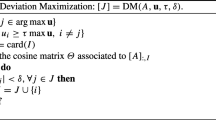Abstract
We present a block algorithm for computing rank-revealing QR factorizations (RRQR factorizations) of rank-deficient matrices. The algorithm is a block generalization of the RRQR-algorithm of Foster and Chan. While the unblocked algorithm reveals the rank by peeling off small singular values one by one, our algorithm identifies groups of small singular values. In our block algorithm, we use incremental condition estimation to compute approximations to the nullvectors of the matrix. By applying another (in essence also rank-revealing) orthogonal factorization to the nullspace matrix thus created, we can then generate triangular blocks with small norm in the lower right part ofR. This scheme is applied in an iterative fashion until the rank has been revealed in the (updated) QR factorization. We show that the algorithm produces the correct solution, under very weak assumptions for the orthogonal factorization used for the nullspace matrix. We then discuss issues concerning an efficient implementation of the algorithm and present some numerical experiments. Our experiments show that the block algorithm is reliable and successfully captures several small singular values, in particular in the initial block steps. Our experiments confirm the reliability of our algorithm and show that the block algorithm greatly reduces the number of triangular solves and increases the computational granularity of the RRQR computation.
Similar content being viewed by others
References
C.H. Bischof, A block QR factorization algorithm using restricted pivoting, in:Proc. SUPER-COMPUTING '89 (ACM Press, Baltimore, MD, 1989) pp. 248–256.
C.H. Bischof, Incremental condition estimation, SIAM J. Matrix Anal. Appl. 11 (1990) 312–322.
C.H. Bischof, A parallel QR factorization algorithm with controlled local pivoting, SIAM J. Sci. Stat. Comput. 12 (1991) 36–57.
C.H. Bischof and P.C. Hansen, Structure-preserving and rank-revealing QR factorizations, SIAM J. Sci. Stat. Comput. 12 (1991) 1332–1350.
C.H. Bischof and G.M. Shroff, On updating signal subspaces, IEEE Trans. Signal Proc. SP-40 (1992) 96–105.
C.H. Bischof and P.T.P. Tang, Robust incremental condition estimation, Preprint MCS-P225-0391, Argonne National Laboratory, Mathematics and Computer Science Division (1991).
C.H. Bischof and C.F. Van Loan, The WY representation for products of Householder matrices, SIAM J. Sci. Stat. Comput. 8 (1987) s2-s13.
T.F. Chan, Rank revealing QR factorizations, Linear Alg. Appl. 88/89 (1987) 67–82.
T.F. Chan and P.C. Hansen, Computing truncated SVD least squares solutions by rank revealing QR factorizations, SIAM J. Sci. Stat. Comput. 11 (1990) 519–530.
T.F. Chan and P.C. Hansen, Some applications of the rank revealing QR factorization, SIAM J. Sci. Stat. Comput. 13 (1992) 727–741.
I.S. Duff, A.M. Erisman and J.K. Reid,Direct Methods for Sparse Matrices (Oxford Press, London, 1987).
L. Eldén and R. Schreiber, An application of systolic arrays to linear discrete ill-posed problems, SIAM J. Sci. Stat. Comput. 7 (1986) 892–903.
L.V. Foster, Rank and null space calculations using matrix decomposition without column interchanges, Linear Alg. Appl. 74 (1986) 47–71.
G.H. Golub, V. Klema and G.W. Stewart, Rank degeneracy and least squares problems, Technical Report TR-456, University of Maryland, Dept. of Computer Science (1976).
G.H. Golub, P. Manneback and P.L. Toint, A comparison between some direct and iterative methods for certain large scale geodetic least-squares problem, SIAM J. Sci. Stat. Comput. 7 (1986) 799–816.
G.H. Golub, Numerical methods for solving linear least squares problems, Numer. Math. 7 (1965) 206–216.
G.H. Golub and C.F. Van Loan,Matrix Computations (The Johns Hopkins University Press, 1983).
T.A. Grandine, An iterative method for computing multivariateC 1 piecewise polynomial interpolants, Comput. Aided Geometric Design 4 (1987) 307–319.
T.A. Grandine, Rank deficient interpolation and optimal design: An example, Technical Report SCA-TR-113, Boeing Computer Services, Engineering and Scientific Services Division (February 1989).
P.C. Hansen, Truncated SVD solutions to discrete ill-posed problems with ill-determined numerical rank, SIAM J. Sci. Stat. Comput. 11 (1990) 503–518.
P.C. Hansen, T. Sekii and H. Shibahashi, The modified truncated SVD-method for regularization in general form, SIAM J. Sci. Stat. Comput. (1992), to appear.
Y.P. Hong and C.-T. Pan, The rank revealing QR decomposition and SVD, Math. Comp. 58 (1992) 213–232.
S.F. Hsieh, K.J.R. Liu and K. Yao,Comparisons of Truncated QR and SVD Methods for AR Spectral Estimations (Elsevier Science, 1991) pp. 403–418.
J. Moré, The Levenberg-Marquardt algorithm: Implementation and theory, in:Proc. Dundee Conf. on Numerical Analysis, ed. G.A. Watson (Springer, 1978).
R. Schreiber and C. Van Loan, A storage efficient WY representation for products of Householder transformations, SIAM J. Sci. Stat. Comput. 10 (1989) 53–57.
G.M. Shroff and C.H. Bischof, Adaptive condition estimation for rank-one updates of QR factorizations, Preprint MCS-P166-0790, Argonne National Laboratory, Mathematics and Computer Science Division (1990).
G.W. Stewart, An updating algorithm for subspace tracking, IEEE Trans. Signal Proc. SP-40 (1992) 1535–1541.
B. Waldén, Using a fast signal processor to solve the inverse kinematic problem with special emphasis on the singularity problem, PhD thesis, Linköping University, Dept. of Mathematics (1991).
Author information
Authors and Affiliations
Additional information
Communicated by M.H. Gutknecht
This work was supported by the Applied Mathematical Sciences subprogram of the Office of Energy Research, US Department of Energy, under Contract W-31-109-Eng-38. The second author was also sponsored by a travel grant from the Knud Højgaards Fond.
This work was partially completed while the author was visiting the IBM Scientific Center in Heidelberg, Germany.
Rights and permissions
About this article
Cite this article
Bischof, C.H., Hansen, P.C. A block algorithm for computing rank-revealing QR factorizations. Numer Algor 2, 371–391 (1992). https://doi.org/10.1007/BF02139475
Received:
Revised:
Published:
Issue Date:
DOI: https://doi.org/10.1007/BF02139475





